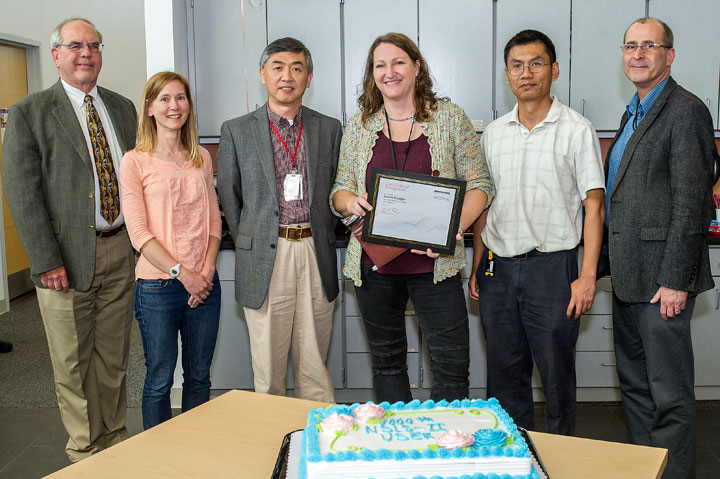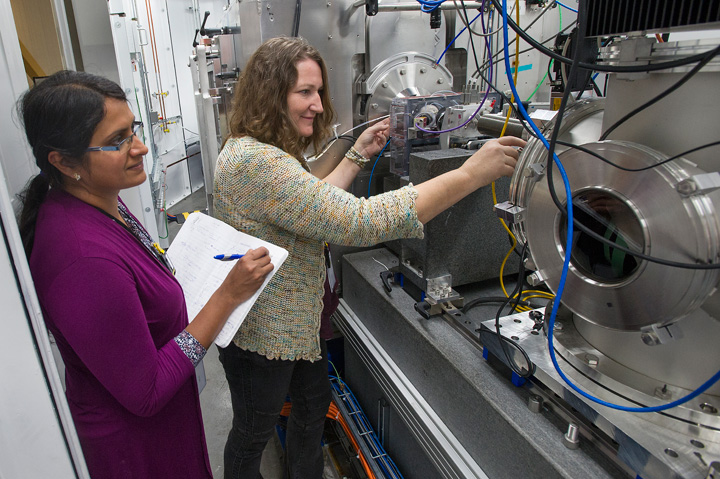New Milestone Reached: 1000th Lifetime User at NSLS-II
July 18, 2017
 enlarge
enlarge
NSLS-II staff celebrates the 1000th lifetime user with loud cheers and a colorful cake. Joanna Krueger (center) joins the celebration as the 1000th lifetime user and guest of honor. From left to right: Michael Bebon, Lisa Miller, Qun Shen, Joanna Krueger, Lin Yang, Paul Zschack.
On June 28, Joanna Krueger, a professor of chemistry at the University of North Carolina at Charlotte (UNC Charlotte), came to Brookhaven National Laboratory to use the ultra-bright light of the U.S. Department of Energy’s (DOE) National Synchrotron Light Source (NSLS-II) for her x-ray scattering studies on “Sleeping Beauty” transposases and became the light source’s 1000th lifetime user. Krueger expected to have a normal day of research at NSLS-II, a DOE Office of Science User Facility, but instead she was the guest of honor to celebrate this milestone together with NSLS-II staff and users.
“Today, we had our 1000th lifetime user walk through the door,” said Qun Shen, Deputy Director for Science at NSLS-II, during the celebration. “Our first general user arrived in July 2015, so we reached this milestone in less than two years of operation, and we expect our user community to continue to grow as we aim to provide the brightest x-ray light and user service.”
NSLS-II has not yet reached its full capabilities since several beamlines are not yet available for general users. Therefore, everyone at NSLS-II was excited about this achievement—and of course its celebration with coffee, cake, and balloons in the afternoon. During the celebration, Shen presented Krueger with a certificate and welcomed her to the facility and its growing user community.
It is a great way to attract users like me who have never been to NSLS-II before—Now that I am here and have seen the facility and its possibilities, I can’t wait to come back.
— Joanna Krueger
“I am glad to finally be here and to use this facility for my research,” said Krueger. “I am impressed by all the improvements: automation for data collection and fast data reduction. I have never seen my data reduced so fast—and I have been doing this work since the mid-nineties. I am very pleased with the facility and the assistance from the beamline staff. It is amazing.”
Krueger has used synchrotron light sources for over 15 years, including NSLS, NSLS-II’s predecessor. For this visit, her beam time proposal was allocated as part of the Joint Access Program between Oak Ridge National Laboratory’s (ORNL) High Flux Isotope Reactor (HFIR, also a DOE Office of Science User Facility) and NSLS-II for combined Small-Angle X-ray Scattering (SAXS) and Small-Angle Neutron Scattering (SANS) experiments. This unique program offers scientists the opportunity to use two complementary facilities and imaging techniques to study their samples through a single beam time proposal.
“It is a great way to attract users like me who have never been to NSLS-II before”, Krueger said. “Now that I am here and have seen the facility and its possibilities, I can’t wait to come back.”
 enlarge
enlarge
Joanna Krueger and Diane Joy change their samples inside the experimental hutch of the Life Science X-ray Scattering (LiX) beamline at NSLS-II.
At NSLS-II, Krueger and Diane Joy, a PhD student also working on this project, will study the so-called Sleeping Beauty transposase, which is an enzyme first isolated from fish in an inactive form but becomes more active when put into human cells. Many other transposase enzymes can be found naturally in human cells. All transposases share the common function of searching for a special gene sequence in our DNA, finding it, untangling the DNA, cutting out the sequence, and moving it to a different place. This natural process is very interesting for medical applications like gene therapy.
“To understand how the enzymes holds onto the DNA is the first step to using it in medicine”, Krueger said. “We can try to make it bind better or bind a different sequence so that we can design new enzymes to insert genes that we want to be inserted. This process can then be used to repair DNA defects or natural mutations.”
To understand this complex process, Krueger and her collaborators use the x-rays from NSLS-II to study the whole complex and ORNL’s HFIR to zoom in on important parts, as well as other techniques to study further details about the enzyme. By combining all these techniques, they can fuse all the details together into a model that explains how the enzymes hold onto the DNA.
“We are very proud to support such a diverse user community with high impact research,” Shen said, “and we expect to attract even more users in the upcoming years as more beamlines open for general users.”
2017-12362 | INT/EXT | Newsroom









